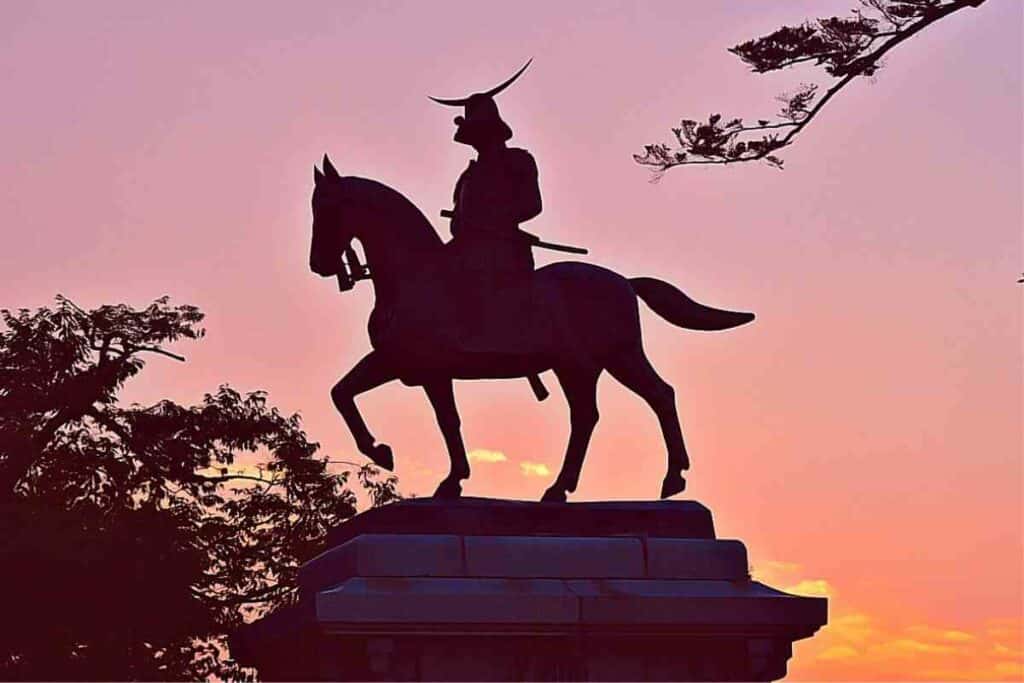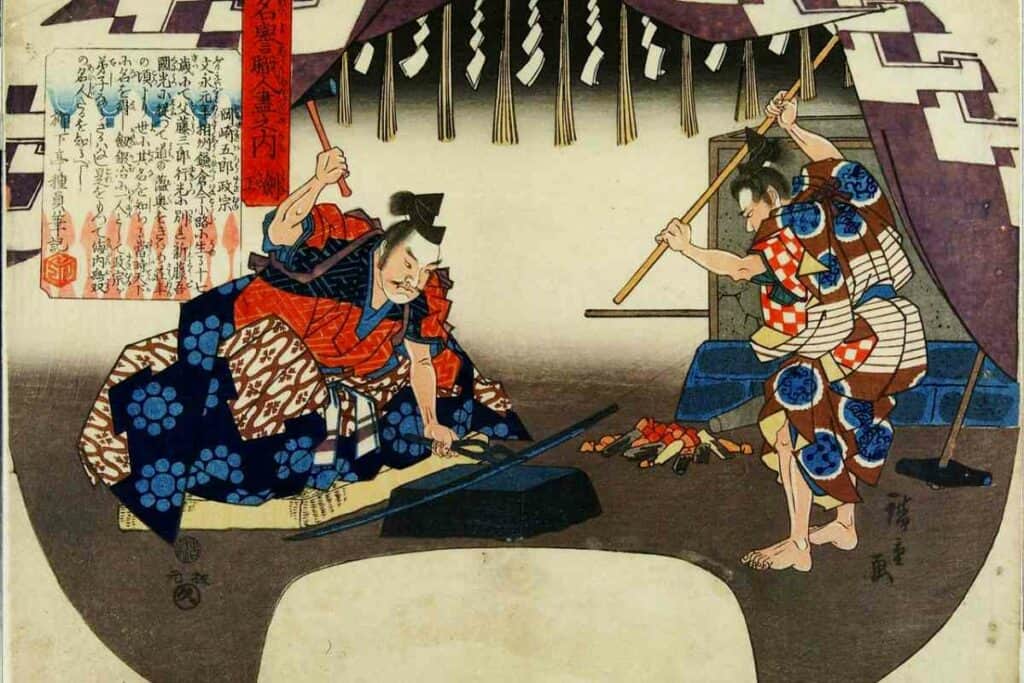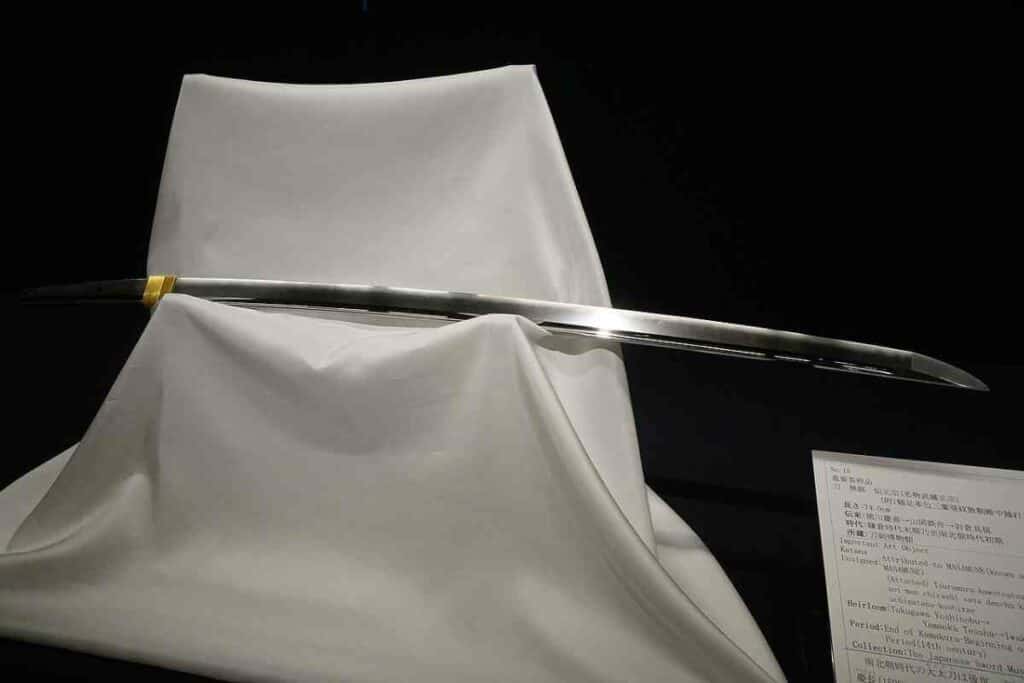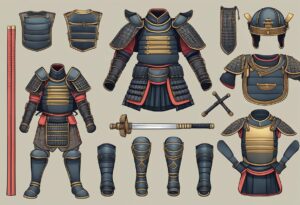The Honjo Masamune is a renowned sword crafted by the legendary swordsmith Goro Nyodo Masamune in the 13th century.
However, there is controversy surrounding the sword’s whereabouts since it hasn’t been seen since WWII.

If you want to know more about the Honjo Masamune, you’ve come to the right article.
Table of Contents
History Of The Honjo Masamune Sword
The Honjo Masamune sword, crafted by Goro Nyudo Masamune during the Kamakura period between 1288 and 1328, is considered to be one of the finest swords in Japanese history.
Its exceptional quality has led to its designation as a National Treasure and is frequently used to represent Bushido or the Way of the Warrior.
The sword’s beauty is not only due to its shape but also the craftsmanship involved in making it.
The blade is inscribed with an ancient writing style known as horimono that includes both kanji characters and images of dragons or other mystical creatures from Japanese folklore.
These engravings display unusual skill, lending a unique story to the sword and making it even more special.
Honjo Masamune sword has an extraordinary history that spans centuries, having passed through the hands of several well-known Japanese figures, including Tokugawa Ieyasu, Oda Nobunaga, and Toyotomi Hideyoshi.
Many historians believe that the name Honjo connects to General Honjo Shigenaga who gained this sword in battle in the 16th century.
Shigenaga was attacked by Umanosuke wielding the Honjo Masamune, which injured him badly but he managed to win the fight and took the sword as a prize. It stayed by his side until around 1592 – 1595 before the General was sent to Fushimi castle in Bunroku and sold the sword to Toyotomi Hidetsugu.
It also played a role in major battles such as Sekigahara which led to the establishment of the Tokugawa Shogunate.
Despite its long history, the Honjo Masamune sword still continues to be admired today for both its beauty and its legendary status in Japan.
Who Was Goro Nyudo Masamune
Goro Nyudo Masamune was a renowned Japanese swordsmith who lived during the Kamakura and Muromachi periods.
He is known for creating the Honjo Masamune sword, which is considered one of the finest swords ever made in Japan.
Many samurai warriors throughout history sought out his works, as he was reputed to be one of the most outstanding swordsmiths of his time.
Initially, he was famous for crafting Tachi swords and daggers, which were predecessors to katanas and tanto.
Some of Goro Nyuodo Masamune’s famous swords include:
- Kotegiri Masamune – a sword that belonged to Oda Nobunaga
- Hocho Masamune – referring to one of the three Tanto Masamune blades
- Fudo Masamune – which belonged to Tokugawa Ieyasu
- Honjo Masamune – the legendary swords that were presented to Tokugawa Shogunate during the Edo period
His genius lay in crafting exceptionally sharp blades with subtle curves and elegant flowing lines that could both cut through armor and still maintain their strength even after years of use.
Goro Masamune was a highly skilled craftsman who lived from around 1264 to 1343.
He worked in the Sagami province during the latter part of the Kamakura period and produced many impressive pieces of art.
Today, his work can still be found in museums and private collections worldwide, continuing to impress collectors and art enthusiasts.
The legacy of the Honjo Masamune sword is expected to be highly valued (if ever found) and respected for generations to come.
Many sword experts would put a price of up to $10 million for the Honjo Masamune if it someday sees the light of day.
Technical Specifications of The Honjo Masamune Sword
The technical specifications of the Honjo Masamune sword are impressive.
This sword is a single-handed, curved katana made of high-quality Japanese steel called tamahagane.
The blade is slightly curved and features the traditional Sugata (shape) of a typical Japanese katana, with a medium to long length of approximately 2 shaku 3 sun 5 bu (about 72.5 cm or 28.5 inches).

It has an ihorimune shape, with shallow sori and extended chu-kissaki. The Hamon (tempering pattern) is nioi-deki midareba, characterized by prominent dashes in the temper line.
Had which is the grain pattern, is mokume and ito hada with masame hada along the shinogi-ji (ridge line). The kissaki is a long and slender o-kissaki with habuchi, leading to a sharp point.
On the tang of the sword, there are two mekugi-ana (holes for securing the handle) and an oval-shaped signature reading ‘Honjo Shigeyoshi’.
While the exact number of Honjo Masamune swords that were created is unknown, it’s believed to be around 150. All of those blades are lost today, or at least none of them are even going to be seen by the public.
All in all, this sword is truly a piece of art that stands out among other katanas.
How Honjo Masamune Sword Influenced Sword-Making in Japan
The Honjo Masamune sword is a highly significant and influential sword in Japanese history, known for its distinct curved blade and construction method.
Even today, its impact on sword-making and techniques is evident.
The sword’s creator, Goro Nyudo Masamune, developed a process that allowed for the creation of a well-balanced weapon with exceptional cutting power and durability.
Many modern Japanese swords now feature similar curved blades, making it an iconic feature of Japanese sword-making.

Modern sword makers in Japan still study the forging techniques used to create the Honjo Masamune.
By combining several different kinds of steel together and folding them multiple times during the heating and hammering process, Goro Nyudo Masamune was able to create a very hard yet flexible blade that could hold an edge longer than swords made by many of his contemporaries.
This technique has become known as “Hamon” and is still used today.
In addition to the forging techniques, the Honjo Masamune also had a significant influence on sword design and aesthetics. The beautiful curves of the blade combined with its intricate engravings make it one of the most recognizable swords in Japanese history.
As such, it has been reproduced multiple times over the centuries, both by modern-day smiths or craftsmen and antique collectors alike.
The Significance of Honjo Masamune Sword In Japan’s Culture
Honjo Masamune swords have held a special place in Japan’s culture for centuries.
For hundreds of years, the blade was considered one of the most beautiful and admired pieces of art in Japanese history.
Many historical figures, including shoguns and daimyos, have been known to possess and wield a Honjo Masamune sword.
The sword is said to have been crafted by the legendary swordsmith Goro Nyudo Masamune during the Kamakura period (1288-1328).
Honjo Masamune swords are highly valued in Japanese culture not only because of their aesthetic appeal, but also because they serve as symbols of power, strength, courage, and loyalty.
These swords hold a significant place in the nation’s history, signifying the honor and respect displayed by Japan’s samurai warriors.
Honjo Masamune swords hold a significant spiritual meaning in Japan as they represent the bravery and devotion of the samurai.
They are believed to possess protective powers that can bring good luck and keep away bad luck.
Therefore, collectors and enthusiasts greatly value these swords.
The Ownership History of Honjo Masamune Sword
The Honjo Masamune sword has had a long and illustrious history, and its ownership has passed through many hands over the centuries.
It is believed to have been forged in the late 13th century by renowned swordsmith Goro Nyudo Masamune.
It was first owned by Umanosuke that lost it in a fight against General Honjo Shigenaga. The general had the sword in his possession until the late 1590s and sold it to Toyotomi Hidetsugu, the nephew of Toyotomi Hideyoshi.
After that, it was owned by various prominent families until the 17th century, when it came into the possession of the Tokugawa family.
From Leyasu to Yorinoby and finally to Letsuna.
The sword remained in the Kii branch of the Tokugawa family all up until the end of World War II which makes the last owner of Honjo Masamune Tokugawa Lemasa.
At the end of World War II, the US banned the production of swords and ordered Japan to give in all of the swords that they had. To set an example, the Tokugawas gave the Honjo Masamune sword to the Meiji police station and haven’t been seen again.
This is where it gets tricky.
Honjo Masamune sword was signed off by U.S. Sargeant Colby Bimore or Cole D.B. Moore (which is probably a spelling error) and from there, it gets lost.
It might have been melted down as a spoil of war, but I really hope it wasn’t.
In Conclusion
The Honjo Masamune is truly a legendary sword and is a symbol of power in Japan.
Even though the Honjo Masamune sword hasn’t been seen since the end of WWII, many sword enthusiasts believe that someone has this legendary sword in their private collection, possibly not knowing its true worth.
- 12 Things Tourists Should NEVER Say in Japan
- Kissing Robot: Exploring the Popularity of the Chinese Kissing App
- Unlocking the Secret Dating Rituals Only Locals Know in Japan
- Samurai Armor: Ancient Protection for Japan’s Elite Warriors
- 10 Amazing Facts About Schools in Japan: Unique Traditions and Educational Practices
- Where can you see snow monkeys in Japan: Best locations and viewing tips









